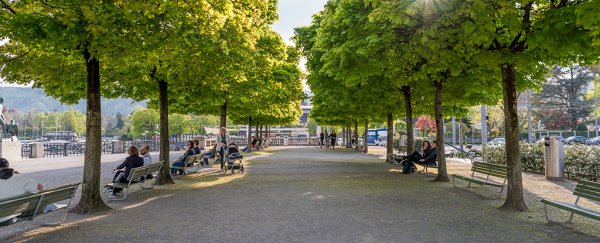There's already a long list of reasons to like trees, we know. Warding off depression could be the latest entry on that list, based on a study of 9,751 residents in Leipzig, Germany.
For a more consistent measure, researchers used antidepressant prescriptions rather than self-reporting to gauge the mental health of communities, and then cross-referenced these statistics with the numbers of street trees in each area.
They reported that more local foliage within 100 metres (328 feet) of the home was associated with a reduced likelihood of being prescribed antidepressants – findings that could be very useful indeed for city planners, health professionals, and governments.
The reduction in antidepressant use linked to street trees was particularly prominent in socioeconomically disadvantaged groups. While it's important not to take such findings too far, the results do hint that urban trees could act as a simple and affordable way of boosting mental health and assist in closing health inequality gaps across society.
"Our finding suggests that street trees – a small scale, publicly accessible form of urban greenspace – can help close the gap in health inequalities between economically different social groups," says environmental psychologist Melissa Marselle from De Montfort University in the UK.
"This is good news because street trees are relatively easy to achieve and their number can be increased without much planning effort."
Outside of socioeconomically disadvantaged groups, the street tree factor was only marginally significant when the team controlled for other factors linked to depression risks, such as employment, gender, age, and weight, suggesting that those who need the most help with depression have the most to gain from more natural surroundings.
And the researchers found that the 100-metre distance was crucial: having more street trees across a wider area didn't make much of a difference to antidepressant prescription rates. The tree species is largely irrelevant, too, based on the findings of this research.
While the study has its limitations – not all depressed people are on antidepressants, for example, and there might be other factors at play affecting mental health – the stats show enough of a relationship to suggest that simply having street trees around is enough to improve the mood of an area as people go about their daily lives.
"Importantly, most planning guidance for urban greenspace is often based on purposeful visits for recreation," says population ecologist Diana Bowler, from the German Centre for Integrative Biodiversity Research (iDiv).
"Our study shows that everyday nature close to home – the biodiversity you see out of the window or when walking or driving to work, school, or shopping – is important for mental health. This finding is especially relevant now in times of the COVID-19 lockdowns."
The researchers talk about adding an "unintentional nature experience into everyday life" to help combat mental health problems, issues that are being made worse by the current global pandemic.
And they also suggest that future studies could look at other types of greenspace and their influence on the risk of depression in an area, as well as digging into different types and sizes of trees; some may work better than others in keeping residents happy and content.
This is besides all the other advantages trees have, of course. We know that they're good at keeping cities cool and reducing stress levels, as well as soaking up carbon dioxide from the air and promoting biodiversity.
"We propose that adding street trees in residential urban areas is a nature-based solution that may not only promote mental health, but can also contribute to climate change mitigation and biodiversity conservation," says Aletta Bonn, an ecosystem services researcher at iDiv.
The research has been published in Scientific Reports.
